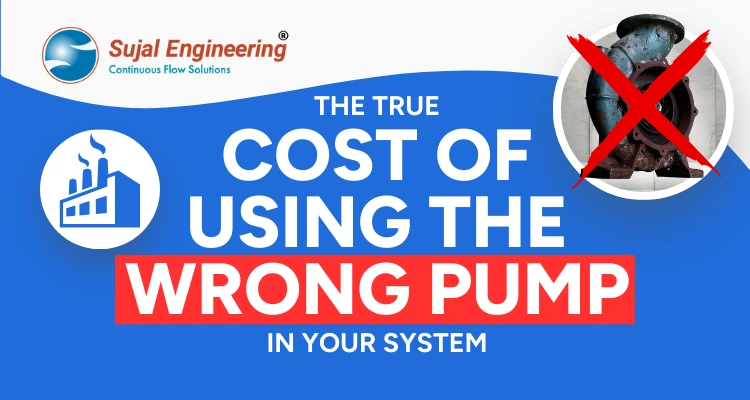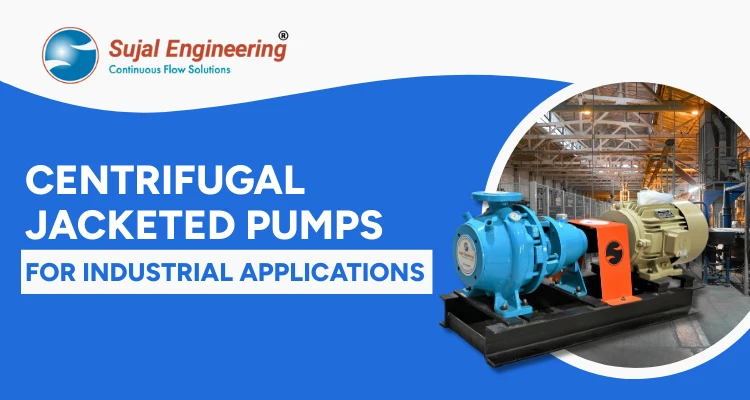The True Cost of Using the Wrong Pump in Your System

Using the wrong pump in your industrial system isn’t just an operational glitch—it’s a financial disaster waiting to happen. The true cost extends far beyond the initial purchase price, often resulting in 3-5x higher total ownership costs over the pump’s lifecycle.
From unexpected downtime costing $50,000 per hour in chemical plants to energy waste that increases utility bills by 40%, pump selection mistakes create severe financial consequences that many plant managers detect too late.
At Sujal Engineering, we’ve learned personally how the right industrial pumps can save companies hundreds of thousands annually, while wrong choices have forced emergency shutdowns and costly system changes.
What Are the Real Costs of Wrong Pump Selection?
Wrong pump selection creates a knock-on effect of hidden expenses that compound over time. The initial savings from choosing a cheaper, unsuitable pump quickly expire when operational realities set in.
Energy waste alone can cost 2-3 times the pump’s purchase price annually. When centrifugal pumps operate outside their efficiency curve, they consume excessive power while delivering poor performance.
Maintenance costs increase by 200-400% when pumps struggle against system requirements. Bearings fail prematurely, seals decline rapidly, and impellers wear unevenly.
Equipment damage extends beyond the pump itself. Wrong pump selection stresses entire systems, damaging downstream equipment, pipes, and control systems.
How Does the Wrong Pump Selection Impact Your Operations?
Unplanned downtime becomes your biggest enemy. When process pumps fail unexpectedly, entire production facilities stop. In chemical processing, this can mean losing 24-48 hours of production while sourcing replacement parts.
Product quality suffers when pumps can’t maintain proper flow rates and pressures. Inconsistent fluid handling leads to product rejections, customer complaints, and potential safety violations.
Safety risks multiply dramatically. Chemical process pumps handling corrosive materials must match exact specifications. Wrong materials of construction can lead to complete failures, impacting personnel and facilities.
Worker productivity drops as maintenance teams constantly inspect failing equipment instead of focusing on preventive maintenance and system optimization.
What Are the Hidden Financial Consequences?
When selecting a hot oil pump for your thermal fluid system, you have several options to consider:
1. Energy Consumption Explosion
Energy costs represent 85% of a pump’s total lifecycle cost. When industrial pumps operate inefficiently, energy consumption can increase by 25-50% compared to properly sized equipment.
A 50 HP pump running 8,760 hours annually at $0.12/kWh costs approximately $32,000 in electricity. Operating at 50% efficiency instead of 80% adds $12,000 annually—enough to buy another pump.
2. Maintenance Cost Multiplication
Reactive maintenance costs 3-5 times more than preventive maintenance. Wrong pump selection forces reactive approaches as equipment fails unpredictably.
Specialized repair services for emergency breakdowns charges premium rates. Rush shipping for replacement parts can cost 200-500% more than standard delivery.
Inventory carrying costs increase as facilities stock multiple spare parts for unreliable equipment instead of standardizing on proven pump designs.
3. Production Loss Acquisition
Each hour of unplanned downtime in process industries averages $50,000-100,000 in lost production. Pharmaceutical and chemical plants face even higher costs when production processes must restart completely.
Quality control failures from inconsistent pumping create waste, rework, and potential regulatory compliance issues that can cost millions in fines and remediation.
Which Pump Types Avoid These Costly Mistakes?
1. Centrifugal Process Pumps for General Applications
Centrifugal pumps offer the widest efficiency range when properly selected. Their simple design minimizes maintenance while providing reliable performance across various flow rates.
Key applications include cooling water systems, general chemical transfer, and low-viscosity fluid handling where consistent flow matters more than precise pressure control.
2. Chemical Process Pumps for Corrosive Service
Specialized materials of construction prevent costly chemical compatibility issues. PVDF pumps and polypropylene pumps handle aggressive chemicals that would destroy standard metallic pumps within months.
Proper chemical resistance eliminates contamination risks that can damage entire product batches and create environmental compliance issues.
3. Thermic Fluid Hot Oil Pumps for High-Temperature Applications
Temperature-specific designs prevent thermal shock and seal failure common in heating systems. Standard pumps often fail within weeks when exposed to thermal cycling.
Energy-efficient designs reduce heating system operating costs by maintaining optimal flow rates without excessive pressure drops that waste energy.
4. Self-Priming Mud Pumps for Challenging Conditions
Eliminates priming issues that cause costly startup delays in applications with entrained air or variable suction conditions.
Reduces maintenance requirements compared to pumps requiring external priming systems that add complexity and failure points.
How to Choose the Right Pump for Your System?
Accurate System Analysis
Calculate true system requirements including future expansion needs. Many facilities underestimate total dynamic head, leading to undersized pumps that struggle constantly.
Consider fluid properties comprehensively—viscosity, temperature, chemical compatibility, and solids content for all impact pump selection and performance.
Lifecycle Cost Analysis
Consider the 5–10-year total ownership costs, not just the initial price. Energy, maintenance, and downtime costs typically match the equipment’s purchase price.
Factor in local service availability and spare parts accessibility. Specialized pump designs may offer marginal performance advantages but create support problems.
Professional Engineering Support
Partner with experienced pump manufacturers who understand your industry’s specific challenges. Sujal Engineering’s technical team helps customers avoid costly selection mistakes through detailed application analysis.
Use your field experience from similar installations to identify potential issues before they become expensive problems.
What Industries Face the Highest Risks?
1. Chemical Processing
Chemical plants face the highest consequence of costs from pump failures due to safety risks, environmental concerns, and complex restart procedures.
Specialized pumps like filter press pumps and vertical sump pumps require precise selection to handle unique process conditions safely.
2. Pharmaceutical Manufacturing
FDA compliance requirements make pump selection critical for maintaining validation status. Wrong choices can invalidate entire production campaigns.
Cleanability and material compatibility become non-negotiable requirements that standard industrial pumps often can’t meet.
3. Food Processing
Sanitary requirements and CIP compatibility demand specialized designs. Standard pumps create safety risks and cleaning challenges.
Temperature cycling from cleaning procedures requires pumps designed for thermal stress that would damage conventional equipment.
Pump Selection Comparison: Right vs. Wrong Choice Impact
| Cost Factor | Right Pump Selection | Wrong Pump Selection | Cost Difference |
| Energy Consumption | Optimized efficiency (75-85%) | Poor efficiency (45-60%) | 40-60% higher |
| Maintenance Frequency | Quarterly preventive | Monthly reactive | 300-400% increase |
| Downtime Hours/Year | 8-16 hours planned | 40-80 hours unplanned | 5-10x more |
| Spare Parts Inventory | Standard components | Specialized emergency parts | 200-300% higher |
| Total 5-Year Cost | $180,000 (example 50HP) | $420,000+ | 130%+ increase |
Take Action: Remove Hidden Pump Costs from Your Operations
The cost of using the wrong pump compounds daily through energy waste, maintenance emergencies, and production disruptions. Every month your delay handling pump selection issues adds thousands to your operational expenses.
Ready to remove these hidden costs from your facility? Contact Sujal Engineering’s technical team for a complete pump audit that identifies optimization opportunities and quantifies potential savings.
Explore our complete range of industrial pumps designed for reliable, efficient operation across chemical, pharmaceutical, textile, and process industries. From centrifugal process pumps to specialized PVDF pumps, we help you choose the right solution for long-term success.




